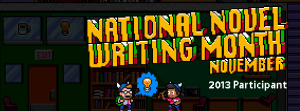Another year, another NaNoWriMo gone by.
On the NaNo website it says that there were over 310,000 participants from all over the world (596 regions), though I’m curious as to how many crossed the finish line (if anyone can point me in that direction, please do). But even if someone wrote only 10,000 words, that’s still 10,000 more words that they didn’t have at beginning of the month. That’s something.
I’m also curious as to how the process went for others and what they do once they’ve finished. Editing is certainly as personal a process as the writing part is.
This year was COMPLETELY different than when I wrote my first NaNoWriMo (INTERGALACTIC) novel two years ago. In 2011, I had been mulling the story and characters over for a few months, I had written an outline (what I call a sequence and beat sheet) and some brainstorming exercises around it all, I had wound myself up, started off with a bang, kept up a steady pace, and even finished early. I also had enough time to hang out in the forum and see how everyone else was doing.
This year I only had the seed of an idea (a location in space and time and 2 characters), had completed one brainstorming exercise, had a fuzzy direction with no sense of how the story would end, and I PANTSED it like crazy. I didn’t have much time early on, or in the middle, so with a week left to go I was still at 18,000 words. I wrote the last 32,000 in the final week. I didn’t have time to reread what I had written the previous day, just went for it. Also, the only contact I had with other NaNoWriMoers (NaNoWriMoists?) was on the @nanosprints twitter page where we encouraged each other to do things like write 1,000 words in 30 minutes.
Both times I was writing something out of my comfort zone. Trying on a new genre. In 2011 it was more plot-based genre fiction (a comedic YA sci fi), this time is was YA contemporary lit. Well, okay, I THOUGHT it was going to be magical realism, but it ended up more in the realm of “unreliable” narrator. The protagonist simply views the world differently than most folks and she’s a little mentally unstable. When it comes time to pitch it I think I’ll call it “The Perks of Being a Wallflower for Queer Girls.” Right now it’s called WINTERSPRING AND SUMMERFALL (although I’m thinking of changing that to Summerfall and Winterspring, whichever sounds better).
I am definitely more of a “planner” by nature when it comes to novel writing, though totally willing to go in new directions if inspired in the moment. I definitely let the magic happen during the creative process. The fascinating thing for me about “pantsing” it this year was that the story still emerged, even without the plan. It sprang from the ethers and I just had to trust. I had to let go of any expectations and just see where it took me.
One of my favourite aspects this time around was when a particular character emerged out of nowhere. A minor character (a gay teacher whose partner is dying from AIDS – this story takes place in the 80’s) turned up, who not only took the story in a wonderful new direction, he added drama, an ally for my protagonist, and a subplot that rounded out the story really magically at the end.
I keep saying that I have a “hot mess” on my hands, but I think when I finally read it (I’m setting it aside until my holiday break), it will be more cohesive than I believe it to be. That happens a lot to me and I have enough years of writing behind me for it to be so. Structure happens a bit intuitively for me due to my fabulous drill sergeant screenwriting instructors at the University of Washington.
So, how did you do? Did you pants it or plan it?
Are you going to give it a break or read it right away?
Set it aside to germinate or dive right into your edit?
And, most of all, what were some of your favourite magical moments?



















